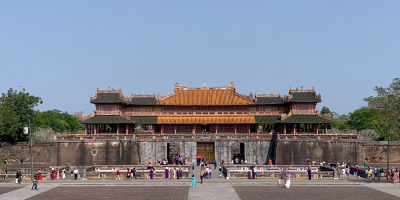Discover The Historic Cu Chi Tunnels In Vietnam
Cu Chi Tunnels in Vietnam is a fascinating experience that takes visitors back in time to the Vietnam War era. Located just outside of Ho Chi Minh City, these tunnels were once used by the Viet Cong soldiers as a strategic base for their guerilla warfare tactics.
1. Overview Cu Chi Tunnels in Vietnam
Despite being constantly targeted by bombing and ground attacks, the tunnels were able to provide shelter, food, and medical facilities for the soldiers, and allowed them to launch surprise attacks on their enemies.
Today, the Cu Chi Tunnels are a popular tourist attraction and an important part of Vietnamese cultural heritage. In this article, we will delve into the fascinating history and culture of the Cu Chi Tunnels, exploring their construction, design, and daily life during the Vietnam War, as well as their significance in Vietnamese identity and literature.

2. Historical Background of Cu Chi Tunnels
Vietnam Cu Chi Tunnels History
The Cu Chi Tunnels have their roots in the early 1940s, when Vietnamese resistance fighters, known as the Viet Minh, first used simple tunnels and trenches to evade French colonial forces. Over time, these tunnels grew more complex and extensive, and were used by the Viet Cong soldiers during the Vietnam War to hide from American and South Vietnamese troops.
Role of the Tunnels during the Vietnam War
Despite constant bombing and efforts by American and South Vietnamese troops to flush out the Viet Cong soldiers, the tunnels remained a crucial base of operations throughout the war. They provided a safe place for the soldiers to live, sleep, and eat, and allowed them to launch surprise attacks on their enemies. The tunnels were also a crucial supply route, allowing the Viet Cong to transport weapons, food, and medical supplies without being detected.

3. Life in Cu Chi Tunnels in Vietnam
Living conditions of the Viet Cong soldiers
Life in the Cu Chi Tunnels was extremely challenging, but the Viet Cong soldiers who lived there were incredibly resilient and resourceful. The tunnels were dark, cramped, and infested with insects and vermin. Conditions were often unbearable, with little fresh air or sunlight, and soldiers were constantly at risk of suffocation or collapse due to lack of oxygen.
Despite these hardships, the soldiers were able to adapt to life in the tunnels and create a semblance of normalcy. They built makeshift beds and hammocks out of bamboo, and used candles or oil lamps for light. They also had access to basic medical facilities, such as rudimentary first aid kits and traditional medicines, and were trained in basic medical procedures to help each other in case of injury or illness.

Food and water sources
Food and water were always in short supply, but the soldiers were able to survive on a diet of rice, vegetables, and sometimes small amounts of meat. They also relied on the nearby Cu Chi river for water, which they boiled to make it safe to drink.
Despite the hardships and danger of living in the tunnels, the soldiers who lived there were fiercely dedicated to the cause of the Vietnamese people and were willing to endure any hardship in order to fight for their freedom.
4. Architecture and Design of Cu Chi Tunnels in Vietnam
Design of the Cu Chi Tunnels in vietnam
The Cu Chi Tunnels in vietnam were ingeniously designed to provide a safe haven for the Viet Cong soldiers during the Vietnam War. The tunnels were dug by hand, using simple tools such as shovels, hoes, and baskets, and were expanded over time to include multiple levels, hidden entrances and exits, and even underground hospitals and schools.
The tunnels were built using a zigzag pattern, which made it difficult for enemy soldiers to shoot straight down the tunnels. They were also designed to be virtually invisible to the enemy, with camouflaged entrances and small air vents that released smoke far from the tunnel openings.

Traps and defenses
The tunnels were incredibly narrow and cramped, with an average height of around 1.2 meters and a width of just 70 centimeters. Soldiers had to crawl or crouch through the tunnels, and were often forced to hold their breath in order to avoid detection by the enemy.
Despite the difficult living conditions, the tunnels were equipped with some basic amenities, such as kitchens, living quarters, and medical facilities. They were also connected by a complex system of underground passages and booby traps, which allowed the soldiers to move quickly and secretly between different sections of the tunnels.
5. How to get to Cu Chi Tunnels from Ho Chi Minh?
By Tours
One of the easiest and most popular ways to visit the Cu Chi Tunnels is to book a tour from Ho Chi Minh City. There are many travel agencies and tour companies that offer half-day or full-day tours to the tunnels, often combined with other popular tourist destinations such as the Mekong Delta or the War Remnants Museum.

By Bus
Another option is to take a public bus from Ho Chi Minh City to the Cu Chi Tunnels. Buses depart from the city center and take around 1.5-2 hours to reach the tunnels. However, this option may be less convenient than a tour, as you will need to navigate the public transportation system and may need to transfer to different buses along the way.
By Motorbike or Car
If you’re feeling adventurous, you can also rent a motorbike or car and drive yourself to the Cu Chi Tunnels. However, keep in mind that traffic in Ho Chi Minh City can be chaotic, and the roads to the tunnels are often congested.
6. Tips for Visiting the Cu Chi Tunnels
- Apply insect repellent: The tunnels are infested with insects, so apply insect repellent before your visit to avoid bites and stings.
- Stay hydrated: It can get hot and humid in the tunnels, so bring a water bottle and stay hydrated throughout your visit.
- Bring cash: There are no ATMs or credit card facilities at the tunnels, so bring enough cash to pay for tickets, food, and souvenirs.
- Plan for the weather: The tunnels are open-air, so be prepared for rain or shine by bringing a raincoat or umbrella in case of rain, sunscreen, and a hat for protection from the sun.
- Respect the history: The Cu Chi Tunnels are an important historical site, so be respectful of the cultural significance of the tunnels and the people who lived and fought there.





Comment (0)